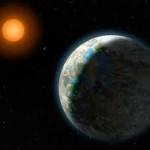US astronomers said that they have spotted a habitable planet which they called as the Goldilocks zone for life. The climatic temperature is just right, not too hot and not too cold, the planet size is neither too big nor too small for habitation.
The astronomers have discovered the planet orbiting a nearby star, and believe there could be many more planets similar to it in space.
The planet has been known only as Gliese 581g which it could have water on its surface has been found orbiting in the middle of the habitable zone of the red dwarf star tagged as Gliese 581.
Liquid water and an atmosphere are necessary to sustain life according to scientists. The discovered planet has a mass three to four times that of earth and an orbital period of 37 days.
Its mass indicates that it is probably a rocky planet and has enough gravity to hold on to an atmosphere, according to Steven Vogt, a professor of astronomy and astrophysics at the University of California, Santa Cruz and one of the leaders of the team that discovered the planet.
The researchers believed that if the planet has a rocky composition like the earth, its diameter would be approximately 1.2 to 1.4 times bigger that of earth.
The surface gravity, they said would be approximately the same or slightly higher than that of Earth’s, therefore a person could easily walk upright on the planet, Vogt said.
The planet Gliese 581g, was discovered by scientists during the 11 years working on the Lick-Carnegie Exoplanet Survey in observing the red dwarf star Gliese 581, which is 20 light years from Earth.
For astronomers, it has considered 11 years of observation as short time and 20 light years which is approximately 117.5 trillion miles distance rather close.
“The fact that we are able to detect this planet so quickly and so nearby tells us that planets like this must be really common,” Vogt said.
The planet is described to have tidally locked up to its star, that is one side is always facing the star exposing it into a perpetual daylight while the other side is in perpetual darkness.
The actual temperature according to scientists would range from blazing hot on the side facing the star to freezing cold to the dark side.
Surface temperatures decreasing going to the darkside and increasing going to the light side. The habitable portion is between darkness and light.
